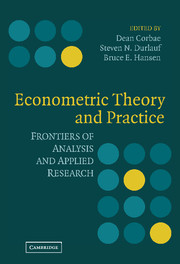Book contents
- Frontmatter
- Contents
- Preface: In Praise of a Remarkable Teacher
- Contributors
- Introduction
- PART I HIGHER-ORDER ASYMPTOTICS
- PART II IV SPECIFICATION TESTS
- 3 Specification Tests with Instrumental Variables and Rank Deficiency
- 4 Asymptotic Normality of Single-Equation Estimators for the Case with a Large Number of Weak Instruments
- 5 Improved Inference in Weakly Identified Instrumental Variables Regression
- PART III NONSTATIONARITY
- PART IV LAD AND QUANTILE REGRESSION
- PART V NONSTATIONARY PANELS
- Index
3 - Specification Tests with Instrumental Variables and Rank Deficiency
Published online by Cambridge University Press: 05 June 2012
- Frontmatter
- Contents
- Preface: In Praise of a Remarkable Teacher
- Contributors
- Introduction
- PART I HIGHER-ORDER ASYMPTOTICS
- PART II IV SPECIFICATION TESTS
- 3 Specification Tests with Instrumental Variables and Rank Deficiency
- 4 Asymptotic Normality of Single-Equation Estimators for the Case with a Large Number of Weak Instruments
- 5 Improved Inference in Weakly Identified Instrumental Variables Regression
- PART III NONSTATIONARITY
- PART IV LAD AND QUANTILE REGRESSION
- PART V NONSTATIONARY PANELS
- Index
Summary
INTRODUCTION
This chapter studies some problems concerning two commonly used instrumental variable (IV)-based misspecification tests in linear models. One is Sargan's (1958, 1959) test of overidentifying restrictions, and the other is the Durbin–Hausman–Wu test based on the ordinary least squares – instrumental variables estimator (OLS–IV) contrasts. What causes these problems is the potential rank deficiency of a certain moment matrix. This chapter extensively uses orthogonal groups of matrices and their invariance properties to investigate these issues. As shown in Phillips' (1989a) treatment of “partially identified models,” coordinate rotations by orthogonal matrices are useful in studying a rank deficiency problem. Moreover, the theory of group invariance often simplifies derivations of seemingly complicated distributions as exemplified by a series of papers by Phillips (1984; 1985a,b; 1986a,b; 1989b).
It has been recognized that some IV-based misspecification tests can fail to detect misspecification in certain cases. Newey (1985) provides a unified framework for misspecification tests based on the generalized method of moments (GMM) and points out a potential failure of such tests. That is, if the departure from the moment condition is in certain directions, the GMM misspecification tests have no power. See also Tauchen (1986) and Holly (1982). Because IV estimators are special cases of GMM, this potential failure clearly applies to some misspecification testing procedures based on (linear) IV estimators such as Sargan's test.
- Type
- Chapter
- Information
- Econometric Theory and PracticeFrontiers of Analysis and Applied Research, pp. 59 - 81Publisher: Cambridge University PressPrint publication year: 2006
- 4
- Cited by



